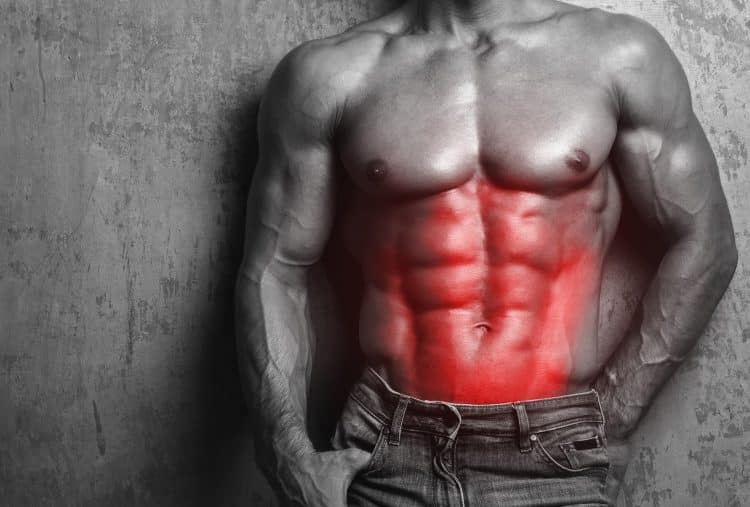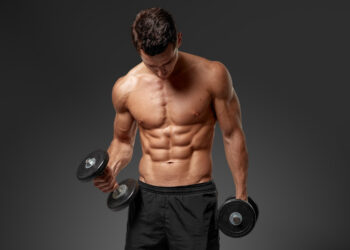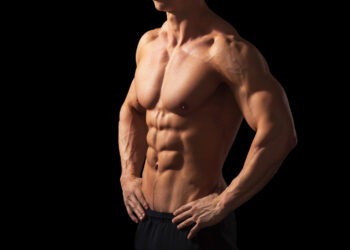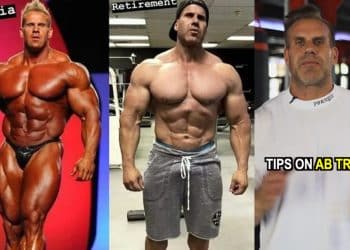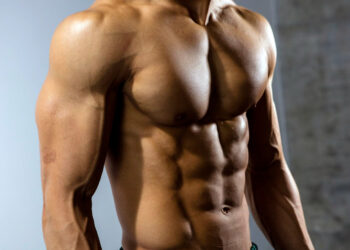We love floor-based abs exercises as much as the next guy, but sometimes it’s nice not to lie on a sweaty gym mat or dirty floor to do sit-ups or crunches.
Also, floor-based abs exercises are not exactly functional. After all, apart from sitting up in bed, when was the last time you used your abs to pull your torso upright? Floor abs exercises are often challenging to load, too. You’ve got to rely on the weight of your upper body or legs to hit your abs. Depending on your body size and strength, this may be too much or too little weight to work your abs.
The good news is that you can do many great abs exercises while standing. Some are easy and ideal for beginners, while others are hardcore and perfect for more advanced exercisers.
As a veteran personal trainer with over 35 years of hands-on experience, I’ve helped many people build a ripped six-pack. In this article, I share the 10 most effective standing ab exercises to help you achieve the same objective.
Recent Updates: On May 27, 2024, Fitness Volt’s Senior Editor, Vidur Saini (American Council on Exercise-CPT), revised the exercise list to include only the most effective standing abdominal exercises and a science-backed ab workout. We’ve also added actionable expert tips that you can implement immediately. Level Up Your Fitness: Join our 💪 strong community in Fitness Volt Newsletter. Get daily inspiration, expert-backed workouts, nutrition tips, the latest in strength sports, and the support you need to reach your goals. Subscribe for free!
10 Best Standing Abs Exercises
Add the following exercises to your arsenal:
- Standing cable crunch
- Pallof press
- Overhead Pallof press
- Landmine full-contact twists
- Cable high-to-low woodchop
- Standing oblique crunch
- Standing bicycle crunch
- Single-arm farmer’s walk
- Standing ab wheel rollout
- TRX Hip drops
1. Standing cable crunch
| Sets & Reps | 3 x 10-15 |
| Equipment Needed | Cable machine, rope attachment |
| Target Muscles | Rectus abdominis (upper emphasis), transverse abdominis |
The key to an effective crunch is shortening the distance between your sternum and pelvis. Making a discernable C-shape with your spine ensures that your abs do the work, not your hip flexors. If you can’t feel this exercise in the front of your abdomen, there is a good chance you are flexing your hips more than your spine.
“Instead of pulling the ropes straight down, bring your elbows toward your hips,” said Saini. “This slight adjustment fires up the rectus abdominis muscles for peak contraction.”
Steps:
- Fix a rope handle to a high cable pulley machine. Take one end in each hand and take a step backward to engage the weights.
- Pull the handles down so your hands are in front of your shoulders.
- Stand with your knees slightly bent, feet shoulder-width apart.
- Flex your spine and draw your sternum down toward your pelvis.
- Lift your chest to get a stretch in your abs, and repeat.
Benefits:
- Easy to scale by reducing or increasing the load.
- More effective than the kneeling variation of this exercise.
- A very lower back-friendly core exercise.
Coach Tips:
- Exhale as you contract your abs to increase muscle engagement.
- Hold the handles in one hand only to work the obliques more.
- You can also do this exercise with a resistance band:
| Difficulty | Progression | Regression |
| Beginner | Increase reps/sets, add light resistance band | Decrease reps/sets, remove resistance band |
| Intermediate | Increase weight on the cable machine, slow down the tempo | Lighter weight, faster tempo |
| Advanced | Add isometric hold at peak contraction, superset with other ab exercises | Assisted cable crunch with band |
2. Pallof press
| Sets & Reps | 3 x 8-12 per side |
| Equipment Needed | Cable machine, D-handle attachment |
| Target Muscles | Obliques, transverse abdominis, erector spinae |
The Pallof press was invented by Bostonian physical therapist John Pallof. This is an anti-core exercise, meaning you’ll use your midsection to prevent unwanted movement. This is how your core often has to work in nature, making Pallof presses a very functional abs exercise.
Saini recommends controlling your breathing pattern to increase intra-abdominal pressure. Exhale sharply as you press the handle away from your body.
Steps:
- Attach a D-shaped handle to a cable machine set to mid-chest height.
- Stand side-on to the pulley with the handle in both hands. Your feet should be about shoulder-width apart, knees slightly bent. Brace your core.
- Pull your hands into your chest and step away from the machine.
- Without moving your hips or shoulders, extend your arms out in front of you.
- Bend your arms and return your hands to your chest.
- Repeat for the required number of reps and then switch sides.
Benefits:
- Minimal lower back stress.
- Very scalable — just add or subtract weight according to your needs.
- An excellent exercise for integrating the upper and lower body with the core.
Coach Tips:
- The narrower your stance, the more challenging this exercise becomes.
- Hold your arms at varying heights to work your core from different angles.
- Do this exercise with a resistance band for home workouts.
| Difficulty | Progression | Regression |
| Beginner | Increase reps/sets, add slight resistance | Decrease reps/sets, no resistance |
| Intermediate | Increase the resistance on the cable machine, longer isometric hold | Lighter resistance, shorter hold |
| Advanced | Kneeling Pallof press, half-kneeling Pallof press | Seated Pallof press |
3. Overhead Pallof press
| Sets & Reps | 3 x 8-12 per side |
| Equipment Needed | Cable machine, D-handle attachment |
| Target Muscles | Obliques, transverse abdominis, erector spinae (increased shoulder stability demand) |
Where regular Pallof presses are an anti-rotation exercise, this version is an anti-extension exercise, so it hits your anterior abs more than your obliques. This challenging exercise is basically a standing, moving plank.
Engage your lats by pulling your shoulders down and back as you press overhead, urges Saini. Doing this improves your stability and balance.
Steps:
- Attach a rope handle to a high pulley. Grab the handle and then turn your back to the machine.
- Hold your hands at shoulder height and brace your core. Adopt a split stance for balance.
- Without leaning forward or backward, press your arms above your head.
- Return your hands to your shoulders and repeat.
Benefits:
- A full-body standing abs exercise.
- Good for increasing core and upper body stability.
- Can be made as hard or as easy as required by adjusting the weight
Coach Tips:
- You can also do this exercise with a resistance band.
- The closer/narrower your feet, the more challenging this exercise will be.
- Exhale as you raise your arms to increase core engagement.
| Difficulty | Progression | Regression |
| Beginner | Increase reps/sets | Decrease reps/sets |
| Intermediate | Increase resistance, longer isometric hold, single-leg | Lighter resistance, shorter hold, both feet planted |
| Advanced | Use an unstable surface (bosu ball), superset with overhead carry | Standing overhead Pallof press |
4. Landmine full-contact twists
| Sets & Reps | 3 x 10-15 per side |
| Equipment Needed | Landmine attachment, barbell |
| Target Muscles | Obliques, rectus abdominis, transverse abdominis |
A landmine is a simple device that turns a barbell into a functional workout machine. You can do many exercises with a landmine, and they’re all excellent. No landmine? No problem! Just wedge the end of your barbell into a corner or against the bottom of a squat rack. Full contact twists are an excellent standing core exercise.
“Many exercisers leave gains on the table by only twisting their arms and not their rib cages,” said Saini. “This subtle change engages the deeper core muscles, which can boost spinal stability and rotational power.”
Steps:
- Place one end of your barbell in the landmine, and grab the other in both hands.
- Lift the bar and hold it above your head with your hands close together, palms facing inward.
- Brace your core and pull your shoulders down and back. Press the bar forward and down into the landmine.
- Maintaining your core tension, rotate your shoulders and arms and lower the bar down to one side. Turn your hips in the same direction as your arms.
- Lift the weight back to the center and repeat on the opposite side.
- Continue alternating sides for the duration of your set, driving your arms forward and down throughout.
Benefits:
- An excellent exercise for athletes.
- Can be performed with heavy weights to develop a strong, powerful core.
- A full-body, functional, total core strength exercise.
Coach Tips:
- Raise the weight explosively but lower it slowly to make this exercise as effective as possible.
- Don’t just use your arms for this exercise; put your entire body into each rep.
- Keep flexing your abs throughout.
| Difficulty | Progression | Regression |
| Beginner | Increase reps/sets | Decrease reps/sets, no barbell |
| Intermediate | Add resistance band, increase rotation range | A lighter band, a smaller rotation range |
| Advanced | Use a heavier barbell, single-arm variation | Russian twists with bodyweight |
5. Cable high-to-low woodchop
| Sets & Reps | 3 x 10-12 per side |
| Equipment Needed | Cable machine. D-handle attachment |
| Target Muscles | Obliques, rectus abdominis, serratus anterior, shoulders |
This exercise is so-called because, when you do it, you look a little like you are chopping wood. The cable woodchop is an effective oblique strengthener and teaches you how to integrate your upper and lower body with your core.
Steps:
- Attach a D-shaped handle to a high cable machine. Hold the handle in both hands and then stand sideways onto the pulley. Take 1-2 steps away to engage the cable.
- Stand with your feet about shoulder-width apart, knees slightly bent.
- Keeping your arms straight, turn your upper body through 180 degrees so your hands travel diagonally downward to hip height.
- Return to the starting position and repeat.
- Do the same number of reps on each side.
Benefits:
- Easy to modify for all levels of exerciser.
- Teaches you how to brace your core while using your upper and lower body.
- A very lower back-friendly exercise.
Coach Tips:
- You can also do this exercise with horizontal arms or working from low to high.
- Try shifting your weight from one leg to the other as you rotate your upper body.
- No cable machine? Do this exercise with a resistance band attached to a sturdy anchor.
| Difficulty | Progression | Regression |
| Beginner | Increase reps/sets, slow tempo | Decrease reps/sets, faster tempo |
| Intermediate | Increase resistance, add isometric hold at end range | Lighter resistance, no hold |
| Advanced | Use single-arm variation, add rotation | Assisted woodchop with band |
6. Standing oblique crunch
| Sets & Reps | 3 x 15-20 per side |
| Equipment Needed | NA |
| Target Muscles | Obliques |
Not all standing abs exercises use cables or weights to strengthen your core. This movement might not be overly challenging, but it provides your abs and obliques with a pleasant workout. Best of all, you can do it anywhere and anytime, as no equipment is involved.
“Instead of aiming your elbow towards your knee, visualize touching your hip bone with your elbow,” said Saini. “This cue emphasizes the oblique contraction and minimizes the involvement of the hip flexors.”
Steps:
- Stand with your feet about shoulder-width apart. Clasp your hands behind your head and press your elbows out and back to open your chest. Brace your core.
- Bend one leg and lift your knee out and up. Simultaneously lean sideways and lower your elbow down toward your knee.
- Lower your leg, stand back up, and repeat.
- Do the required number of reps and then switch sides.
Benefits:
- A standing, equipment-free abs exercise you can do anywhere and anytime.
- Ideal for beginners.
- A good way to mobilize your hips and lower back as you work your abs.
Coach Tips:
- Do this exercise with an alternating action if preferred.
- Make this exercise harder by wearing ankle weights.
- Pause at the mid-point of each rep to maximally contract your abs and make this exercise more effective.
| Difficulty | Progression | Regression |
| Beginner | Increase reps/sets | Decrease reps/sets |
| Intermediate | Add a light dumbbell to one hand | No weight |
| Advanced | Weighted Russian twists | Side bends with body weight |
7. Standing bicycle crunch
| Sets & Reps | 3 x 15-20 |
| Equipment Needed | None |
| Target Muscles | Rectus abdominis, obliques |
This is an excellent abs exercise. This standing version is far more accessible, making it ideal for beginners. It’s also a useful teaching exercise before attempting full bicycle crunches and can also be used as a warm-up. However, the overload on your abs is pretty low, so make sure you contract your muscles hard with each rep.
For a better serratus anterior engagement, Saini suggests bringing your shoulder blade toward the opposite hip rather than just your elbow toward your knee.
Steps:
- Stand with your feet together, knees slightly bent for balance. Place your hands on your temples. Brace your abs.
- Bend one leg and lift your knee up and across the front of your body. Simultaneously lean forward and lower your opposite knee to your elbow.
- Stand up straight, lower your foot to the floor, and then repeat on the other side.
- Continue alternating sides for the duration of your set.
Benefits:
- A good standing abs exercise for beginners.
- An excellent hip and spine mobility exercise.
- A good move to prepare you for full bicycle crunches.
Coach Tips:
- Do not clasp your hands behind your neck, as you are more likely to pull with your arms if you do.
- Pause at the midpoint of each rep for maximum effectiveness.
- Drive your supporting foot into the floor to make balancing on one leg easier.
| Difficulty | Progression | Regression |
| Beginner | Increase reps/sets | Decrease reps/sets |
| Intermediate | Slow down tempo, hold at the top position | Faster tempo, no hold |
| Advanced | Weighted bicycle crunch | Decline bicycle crunch |
8. Single-arm farmer’s walk
| Sets & Reps | 3 x 30-45 seconds per side |
| Equipment Needed | Heavy dumbbells or kettlebells |
| Target Muscles | Core (isometric), forearms, grip, shoulders (stability) |
This is another standing core exercise that many people do for an entirely different reason. Farmer’s walks are a well-known grip and general conditioning exercise. However, when performed using just one weight, it quickly becomes a very challenging abs workout.
“While walking, imagine you’re trying to crush a walnut in your armpit on the loaded side,” Saini cues. “This isometric lat contraction makes the exercise more stable.”
Steps:
- Hold a heavy dumbbell or kettlebell in one hand by your side. Brace your core and set your hips and shoulders so they are level.
- Without leaning to either side, walk around your training area.
- Having completed the required distance, lower the weight to the floor, swap hands, and repeat.
Benefits:
- A very functional standing abs exercise.
- An excellent way to spot and fix left-to-right strength imbalances.
- A challenging grip-building exercise.
Coach Tips:
- Use chalk for a better grip.
- Keep your shoulders down and back throughout.
- Lower the weight to the floor as you feel your grip starting to give out. Don’t drop the weight.
| Difficulty | Progression | Regression |
| Beginner | Increase distance or time, lightweight | Decrease distance/time, no weight |
| Intermediate | Increase weight, use a heavier object | Lighter weight, shorter distance/time |
| Advanced | Add contralateral overhead carry, uneven surface | Double farmer’s walk with both hands |
9. Standing ab wheel rollout
| Sets & Reps | 3 x 8-12 |
| Equipment Needed | Ab wheel |
| Target Muscles | Rectus abdominis, obliques, transverse abdominis, shoulders (stability) |
Standing abs exercises don’t come much more challenging than the infamous rollout. This exercise combines extended planks with pull-over arm action, making it one of the most brutal core exercises. Only attempt this move if you have mastered the kneeling ab wheel rollout.
Steps:
- Stand with your feet about shoulder-width apart. Hold the ab wheel with an overhand grip.
- Brace your core, bend your knees slightly, and lean forward to place the ab wheel on the floor in front of your feet.
- Keeping your arms straight, push the roller out and away, lowering your body toward the floor. Extend your arms as far as you can without losing core tension.
- Pull the wheel back toward your feet, lifting your hips up as you do so.
- Continue for the prescribed number of reps.
Benefits:
- Probably the most challenging standing abs exercise.
- Provides an effective lat-building workout.
- An ideal exercise for home workouts.
Coach Tips:
- Do this exercise facing a wall to prevent the wheel from rolling too far.
- Only extend your arms as far as comfortable to avoid injuring your lower back.
- Rest on your knees to make this exercise easier.
| Difficulty | Progression | Regression |
| Beginner | Kneeling ab wheel rollout | Ab wheel rollout from an incline (against a wall) |
| Intermediate | Increase range of motion, slower tempo | Shorter range, faster tempo |
| Advanced | Standing ab wheel rollout, feet elevated | Kneeling ab wheel rollout with a stability ball |
10. TRX hip drops
| Sets & Reps | 3 x 15-20 |
| Equipment Needed | TRX straps |
| Target Muscles | Obliques |
The TRX was invented by a Navy SEAL who wanted a portable training device he could take on deployment. TRXs can be used to replicate many machine and dumbbell exercises, and you can do several unique bodyweight movements with this type of suspension trainer. TRX hip drops are an especially challenging lateral core exercise.
Saini suggests pausing for a second and actively pushing your hips away from the anchor point At the bottom of each rep for maximum oblique engagement.
Steps:
- Attach your TRX to a high anchor point. Hold the handles on both hands and raise your arms above your head so your body is straight.
- Lean your hips out to the side so your body forms a distinct C shape.
- Pull your hips back to the center and repeat.
- Continue for the prescribed number of reps and then switch sides.
Benefits:
- An excellent exercise for home workouts.
- A very functional, challenging standing abs exercise.
- Easy to change the difficulty by varying your range of motion.
Coach Tips:
- Place your feet closer together to make this exercise harder.
- The longer the straps, the more challenging this exercise becomes.
- You can also do this exercise with gymnastic rings and other types of suspension trainer.
| Difficulty | Progression | Regression |
| Beginner | Increase reps/sets | Decrease reps/sets |
| Intermediate | Slow down the tempo, pause at the bottom | Faster tempo, no pause |
| Advanced | TRX hip drop with pike | TRX knee tuck |
Sample Standing Ab Workout
Here is a sample workout for you to try:
| Exercise | Sets | Reps | Rest |
| Standing Cable Crunch | 3 | 10-15 | 60 seconds |
| Pallof Press | 3 | 8-12 per side | 60 seconds |
| Cable High-to-Low Woodchop | 3 | 10-12 per side | 60 seconds |
| Standing Bicycle Crunch | 3 | 15-20 | 30 seconds |
| Single-Arm Farmer’s Walk | 3 | 30-45 sec per side | 60-90 seconds |
Abs Anatomy 101
Here are the midline muscles you must know about:
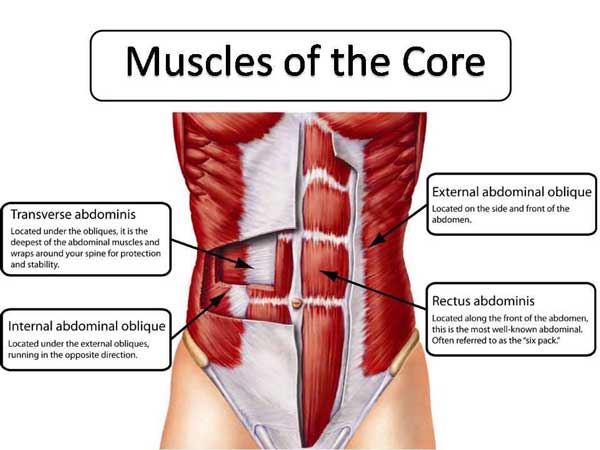
Rectus abdominus
The rectus abdominis is the long, flat muscle on the front of your stomach. It’s divided into vertical halves and horizontal sections by lines of ligamentous tissue, giving it that famous six-pack appearance.
However, you’ll need to be pretty lean to see these lines, typically below ten-percent body fat for men and under 15 percent for women.
The functions of the rectus abdominis are flexion and lateral flexion of the spine.
Obliques
The obliques are basically your waist muscles, and there are two sets — internal and external. These muscles rotate and laterally flex your spine. However, when both sides co-contract, they also play a part in flexion and work alongside your rectus abdominis.
Transverse abdominis
Known as the TVA for short, this muscle encircles your midsection like a weightlifting belt. When you brace your abs, it contracts inward and compresses your internal organs. This creates intra-abdominal pressure, which helps to support your lumbar spine.
So, while you won’t be able to see your TVA working, you will be able to feel it. The TVA is involved in all standing abs exercises.
Level Up Your Fitness: Join our 💪 strong community in Fitness Volt Newsletter. Get daily inspiration, expert-backed workouts, nutrition tips, the latest in strength sports, and the support you need to reach your goals. Subscribe for free!
Erector spinae
The erector spinae is a group of three muscles, each of which is divided into three sections. These muscles run up either side of your spine and are involved in extension and lateral flexion. Many standing core exercises also involve the erector spinae, despite the fact they’re technically back muscles. In most cases, the erector spinae act as stabilizers.
All standing ab exercises involve all of these muscles. However, depending on the movement performed, some will be working harder than others.
Benefits of Standing Abs Exercises
While there is nothing wrong with floor-based abs exercises, standing abs exercises offer some noteworthy advantages and benefits. These include:
Increased functionality
Your core plays a critical role in most human movements. In some situations, it acts as a stabilizer to prevent unwanted movement of your spine. In others, the core is responsible for generating force, e.g., pushing, pulling, and throwing.
Regardless of what they are doing, most of these activities occur when you’re on one or two legs and not lying on your back. Therefore, standing abs exercises are often more functional than their supine counterparts.
Comfort
Standing abs exercises are often more comfortable than similar exercises performed lying on the floor. An exercise mat will help, but one may not be available. With no pressure on your lower back, standing abs exercises are usually more comfortable than floor-based movements.
Convenience
Not everyone trains in a well-equipped gym. Some people prefer to work out in playgrounds, parks, or other large open spaces. Sure, you could take a mat with you for abs exercises, but that’s unnecessary if you do standing abs exercises.
With no mat required and often very little equipment, you can do some standing exercises anywhere and anytime, making them the perfect excuse-free workout.
No more mobility issues
Seniors and people with mobility issues may find getting down on the floor to do sit-ups, crunches, etc., awkward. Getting back up may present an even more significant challenge.
Standing Abs Exercise Drawbacks
Standing abs exercises are generally safe and effective. However, there are a couple of drawbacks to consider, too:
Limited loading
While there are numerous standing abs exercises that utilize an external load, other movements rely on your body weight for resistance. Because of the direction of gravity, this may mean there is very little tension on the muscles you’re training.
You can contract the target muscles harder to get a better training effect, but, even then, some exercises will be too easy if you already have a well-conditioned core.
Lack of understanding
Holding a weight in your hands and then twisting your torso does NOT load your obliques. The force is vertical, whereas the obliques work in the transverse plane, i.e., horizontally. In essence, there is no resistance to rotation.
It doesn’t matter if you hold a 20-pound weight or a 100-pounder; twisting with a weight in your hands won’t challenge your obliques. However, your arms will probably get a good workout!
Similarly, doing standing crunches are all but pointless, as the weight (your upper body) is pulling your spine into flexion — your abs aren’t doing much, if any, of the work.
Instead, think about the function of the muscles you want to engage, perform movements that work that muscle, and then apply a load, if necessary, to make that movement more challenging.
FAQs
1. Will these standing abs exercises give me a six-pack?
While many of these exercises involve your six-pack muscle – the rectus abdominis — there is no guarantee that doing them will give you six-pack abs. That’s because, for the contours of your abs to be visible, you need to have a low body fat percentage. This is typically 10 percent or less for men and below 15 percent for women.
It’s entirely possible to have well-develop abs but for them not to be visible because they’re hidden under a layer of fat.
So, while these standing abs exercises COULD lead to a six-pack, your results hinge on your diet as much as your workouts.
2. How many reps and sets should I do of these exercises?
You can do anywhere from 5 to 30 reps to train your abs. Low reps with heavy weights are best for building brute strength, while higher reps and lighter loads are better for endurance, hypertrophy, and general fitness.
However, some exercises lend themselves to higher or lower reps. For example, suitcase deadlifts work well with bigger loads, while standing bicycle crunches are more suitable for higher reps.
Very high reps, i.e., more than 30, are not recommended as they are largely a waste of time and not challenging enough to be effective.
Regardless, you should take each set to within a couple of reps of failure. Easy sets won’t have much of an effect on the condition of your abs.
Two to four sets should be sufficient for most people. If you feel you need to do more than this, you probably aren’t training close enough to failure, or you are resting too long between sets.
3. Are standing abs exercises better than those performed lying down?
While standing abs exercises offer several advantages, that doesn’t mean they’re better than more traditional lying abs exercises. Ultimately, the best exercises for you are the ones you like, and that meet your workout needs.
If you want to isolate your abs, lying exercises are often best, as they don’t involve many additional muscle groups. But, if you want a more functional workout, standing exercises are arguably the better choice.
Or, you could just combine standing and lying abs exercises and enjoy all the benefits these two different types of training provide. There is no need to choose between them.
4. Will these exercises burn belly fat?
Many people think that doing lots of abs exercises will burn belly fat. Sadly, this is nothing but an old exercise myth. Your body stores and then burns fat from all over your body, not just from the areas you train. As such, if you want to burn fat and get lean, you need to work your entire body and not just where you want to lose the fat from.
So, sorry, these exercises will NOT burn belly fat.
Closing Thoughts
There are plenty of standing abs exercises that are every bit as effective as the ubiquitous crunches, sit-ups, and leg raises.
Movements like cable high-to-low woodchops, standing cable crunches, and standing bicycle crunches are ideal for those times when you don’t want to lie down or just want to hit your abs from a different, more functional angle.
Are standing abs exercises better than ab exercises done on the floor? Not necessarily. However, they may be more suitable for some exercisers and are worth including in any well-balanced core workout plan.

